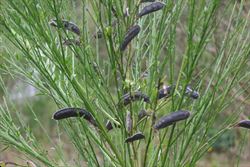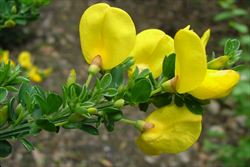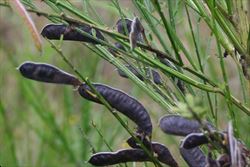Click on images to enlarge

infestation (Photo: Sheldon Navie)

habit (Photo: Sheldon Navie)

habit in full flower (Photo: Sheldon Navie)

habit in fruit (Photo: Trevor James)

close-up of ribbed stems (Photo: Sheldon Navie)

leaves and flowers (Photo: Sheldon Navie)

close-up of flowers (Photo: Sheldon Navie)

immature fruit (Photo: Trevor James)

mature fruit (Photo: Trevor James)

close-up of seeds (Photo: Steve Hurst at USDA PLANTS Database)
Scientific Name
Cytisus scoparius (L.) Link subsp. scoparius
Synonyms
Cytisus scoparius (L.) LinkGenista scoparia (L.) Lam.Sarothamnus scoparius (L.) Wimmer ex W. KochSpartium scoparium L.
Synonyms for the cultivar Cytisus scoparius (L.) Link 'Andreanus':Cytisus scoparius (L.) Link subsp. andreanus (Puiss.) DippelCytisus scoparius (L.) Link var. andreanus (Puiss.) Dippel
Family
Fabaceae (Queensland, the ACT, Victoria, Tasmania and the Northern Territory)Fabaceae: sub-family Faboideae (New South Wales)Leguminosae (South Australia)Papilionaceae (Western Australia)
Common Names
broom, broomtops, common broom, English broom, European broom, Irish broom, Scotch broom, Scotchbroom, Scottish broom, Spanish broom
Origin
Native to Europe (i.e. UK, Ireland, Denmark, Norway, Sweden, Austria, Belgium, Czechoslovakia, Germany, Hungary, the Netherlands, Poland, Switzerland, Italy, Romania, Yugoslavia, France, Portugal, Spain, Belarus, Lithuania, Moldova and western Ukraine), the Azores, the Madeira Islands and the Canary Islands.
Cultivation
Once a very common garden and hedging plant in the temperate regions of Australia. Now less commonly cultivated because of its reputation as a weed. A form with reddish-yellow flowers (i.e. Cytisus scoparius 'Andreanus') is common in cultivated and naturalised populations.
Naturalised Distribution
This species is widely naturalised in the coastal and sub-coastal regions of south-eastern Australia. It is most common in southern and central New South Wales, south-eastern South Australia, Victoria and Tasmania. Also scattered in north-eastern New South Wales and other parts of South Australia, and possibly naturalised in Western Australia.
Naturalised overseas in southern Africa, Asia, New Zealand, USA, Canada and Hawaii.
Habitat
Mainly a weed of temperate regions that infests open woodlands, scrublands, grasslands, forestry plantations, pastures, waterways, coastal environs, roadsides and waste areas.
Habit
An upright (i.e. erect) shrub usually growing 1.2-2 m tall, but sometimes reaching up to 4 m in height.
Distinguishing Features
- an upright and much-branched shrub with greenish-brown, five-angled stems.
- its small softly hairy leaves usually have three leaflets (5-20 mm long and 1.5-10 mm wide).
- its leaves are alternately arranged or clustered together on the branches, however some branches may be almost leafless.
- its bright yellow, pea-shaped, flowers (15-25 mm long) are borne singly, or in pairs, in the leaf forks near the tips of the branches.
- its flattened, elongated pods (25-70 mm long and 8-13 mm wide) are hairy along their margins and turn brown or black as they mature.
Stems and Leaves
The stems are held upright (i.e. erect) and are much-branched from the base of the plant. They are green to brownish-green in colour and prominently five-angled or five-ribbed. Younger stems are covered in silky hairs (i.e. pubescent), while older branches are hairless (i.e. glabrous).
The small leaves are usually compound and have three leaflets (i.e. they are trifoliate), but they may sometimes consist of a single leaflet (i.e. unifoliate). They are shortly stalked (i.e. petiolate) and alternately arranged or clustered together on the branches (some branches may be almost leafless). The leaflets (5-20 mm long and 1.5-10 mm wide) are oval (i.e. elliptic) or elongated (i.e. narrowly-elliptic) in shape, softly hairy (i.e. pubescent) on their undersides or hairless (i.e. glabrous), and have entire margins. The middle (i.e. terminal) leaflet is usually somewhat larger than the others.
Flowers and Fruit
The bright yellow flowers (15-25 mm long), sometimes with red markings, are pea-shaped in appearance. They are borne singly, or in pairs, on short stalks (i.e. pedicels) 5-8 mm long in the leaf forks (i.e. axils) near the ends of the branches. These flowers have five hairless (i.e. glabrous) sepals (5-6 mm long) that are fused into a tube (i.e. calyx tube) for most of their length. The uppermost petal (i.e. standard) is larger and broader (16-20 mm long) than the two side petals (i.e. wing or lateral petals) and the two lower petals are fused together and appear as a single folded petal (i.e. keel). At the entre of the flowers are ten stamens and a hairy ovary topped with a long style and a stigma. Flowering occurs from spring through to early autumn, but mostly during spring and summer (i.e. from September to December).
The fruit is a flattened, elongated pod (25-70 mm long and 8-13 mm wide) that turns from green to brown or blackish in colour as it matures. These pods are hairy along their margins and contain 5-22 seeds. The rounded (i.e. ovate-cordate) and flattened seeds (2.5-4 mm long and 2-2.5 mm wide) are brown, yellowish-brown or greenish-yellow in colour. They are shiny in appearance, smooth in texture and have a small yellowish-brown projection (i.e. aril).
Reproduction and Dispersal
This species reproduces by seed, which are usually ejected from their seed pods, thereby aiding their spread.
Seeds are also dispersed by vehicles, animals (e.g. birds, ants, cattle and horses), water, in dumped garden waste and in contaminated agricultural produce.
Environmental Impact
This species is regarded as a significant environmental weed in Victoria, South Australia, New South Wales and Tasmania and is actively managed by community groups in Tasmania and New South Wales. During a recent survey, it was listed as a priority environmental weed in seven Natural Resource Management regions, making it one of the most widespread priority environmental weed species in Australia. The total area infested with English broom (Cytisus scoparius subsp. scoparius) was estimated to be over 200 000 hectares in 2001. The New South Wales Scientific Committee is considering declaring the invasion and establishment of this species to be a "key threatening process" in New South Wales.
English broom (Cytisus scoparius subsp. scoparius) readily invades natural ecosystems where it competes with native plants and changes the habitat occupied by native animals. Dense stands of this species will shade out native groundcover plants and prevent the regeneration of eucalypt seedlings. It is particularly invasive and difficult to eradicate in open woodlands, but is also found in grasslands, forests, riparian areas and alpine vegetation. It poses a serious threat to conservation areas and has invaded several significant rserves (e.g. Barrington Tops National Park, Kosciuszko National Park, and World Heritage Areas in western Tasmania).
A number of plant and animal species listed as rare or threatened are found only in areas infested by this spcies. These include the Barrington Tops ant orchid (Chiloglottis platyptera), the veined doubletail orchid (Diurus venosa), the leafy greenhood orchid (Pterostylis cucullata), the elegant greenhood orchid (Pterostylis elegans), the slaty leaf orchid (Prasophyllum fuscum), polblue eyebright (Euphrasia ciliolata), fragrant pepperbush (Tasmannia glaucifolia), broad-leaved pepperbush (Tasmannia purpurascens) and the broad-toothed rat (Mastacomys fuscus).
It is also a serious problem in other parts of the world (particularly in New Aealand and western USA), and has been listed in the Global Invasive Species Database.
Other Impacts
English broom (Cytisus scoparius subsp. scoparius) also provides shelter for feral animals, such as pigs and horses, that can affect native plants and animals in neighbouring areas. It is also a problem in pastures grazed by cattle and in forestry plantations in Tasmania. In pastures it can form thickets that significantly reduce grazing capacity and restrict access to water. The seeds of this species are also considered poisonous to humans.
Legislation
This species is declared under legislation in the following states and territories:
- ACT: C2 - a pest plant that must be suppressed, and C4 - prohibited pest plant (a pest plant whose propagation and supply is prohibited). This declaration also applies to all Cytisus spp.
- New South Wales: Class 4 - a locally controlled weed. The growth and spread of this species must be controlled according to the measures specified in a management plan published by the local control authority and the plant may not be sold, propagated or knowingly distributed (in a large number of local authority areas). See the New South Wales Department of Primary Industries Noxious Weeds List at http://www.dpi.nsw.gov.au for more detailed information on which local areas are covered in these declarations.
- South Australia: 5* - this species is declared under Class 5b, and control of this species is required in part of the state only. For information about legislation for specific areas see the Consolidated Proclaimed Plants List, produced by Primary Industries and Resources, South Australia.
- Tasmania: D - the importation or sale of this species is prohibited and measures to reduce its population in an area, eradicate it from an area, or restrict it to a particular area may be required.
- Victoria: C7 - a regionally controlled weed in the Wimmera, Corangamite, Port Phillip East, Goulburn, North East, West Gippsland and East Gippsland regions, where landholders must take all reasonable steps to control it and prevent its spread on their land and the roadsides which adjoin their land.
- Western Australia: Prohibited - on the prohibited species list and not permitted entry into the state.
Management
For information on the management of this species see the following resources:
- the Victorian Department of Sustainability and Environment Landcare Note on this species, which is available online at http://www.dse.vic.gov.au.
- the Tasmanian Department of Primary Industries and Water Weed Service Sheet on this species, which is available online at http://www.dpiw.tas.gov.au.
Similar Species
English broom (Cytisus scoparius subsp. scoparius) is similar to spiny broom (Calicotome spinosa), gorse (Ulex europaeus), flax-leaf broom (Genista linifolia), Montpellier broom (Genista monspessulana) and Madeira broom (Genista stenopetala) at a distance. All of these shrubs produce masses of yellow pea-shaped flowers, however they can be distinguished by the following differences:
- English broom (Cytisus scoparius subsp. scoparius) is without spines (i.e. unarmed) and has leaves with three small, oval-shaped, leaflets (i.e. trifoliate leaves) that are 5-20 mm long. Its pods are relatively large (25-70 mm long), elongated in shape, and only have hairs along their edges.
- spiny broom (Calicotome spinosa) is spiny (i.e. armed), and has leaves with three small leaflets (i.e. trifoliate leaves) that are 6-12 mm long. Its pods are moderately large (up to 40 mm long), flattened, hairless (i.e. glabrous) and end in a small spine.
- gorse (Ulex europaeus) is spiny (i.e. armed) and the adult plants tend to lack any true leaves, instead bearing narrow spine-like 'leaves' in clusters along the stems. Its pods are relatively small (10-25 mm long), oblong or egg-shaped (i.e. ovoid), and densely covered in long hairs all over.
- flax-leaf broom (Genista linifolia) is without spines (i.e. unarmed) and has leaves with three narrow leaflets (i.e. trifoliate leaves) that are 20-30 mm long. Its pods are relatively small (15-30 mm long) and covered all over in silky or downy hairs (i.e. pubescent).
- Montpellier broom (Genista monspessulana) is without spines (i.e. unarmed) and has leaves with three relatively large, broad, leaflets (i.e. trifoliate leaves) that are 5-30 mm long. Its pods are relatively small (10-25 mm long) and densely covered all over in silky or downy hairs (i.e. pubescent).
- Madeira broom (Genista stenopetala) is without spines (i.e. unarmed) and has leaves with three relatively large, oval-shaped, leaflets (i.e. trifoliate leaves) that are 8-30 mm long. Its pods are relatively small (25-30 mm long) and densely covered all over in silky or downy hairs (i.e. pubescent).
It may also be confused with the Australian native plant known as native broom (Viminaria juncea), however this species has smaller flowers (7-10 mm long) and much smaller rounded pods (about 4 mm long).

